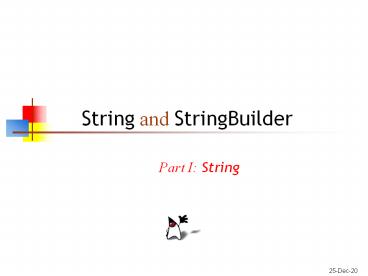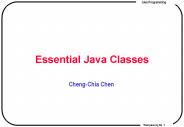String and StringBuilder - PowerPoint PPT Presentation
Title:
String and StringBuilder
Description:
Strings, unlike most other objects, have a defined operation (as opposed to a method) ... are powerful, but can be treacherous if you aren't very familiar with them ... – PowerPoint PPT presentation
Number of Views:121
Avg rating:3.0/5.0
Title: String and StringBuilder
1
String and StringBuilder
- Part I String
2
About Strings
- Strings are objects, but there is a special
syntax for writing String literals - "Hello"
- Strings, unlike most other objects, have a
defined operation (as opposed to a method) - " This " "is String " "concatenation""
- Strings can contain any character, but some of
them must be escaped in order to write them in
a literal - \" stands for the double-quote (") character
- \n stands for the newline character
- \\ stands for the backslash (\)character
- Each of these is written as a two-character
sequence, but represents a single character in
the string
3
Useful String methods I
- char charAt(int index)
- Returns the character at the given index position
(0-based) - boolean startsWith(String prefix)
- Tests if this String starts with the prefix
String - boolean endsWith(String suffix)
- Tests if this String ends with the suffix String
4
Useful String methods II
- boolean equals(Object obj)
- Tests if this String is the same as the obj
(which may be any type false if its not a
String) - boolean equalsIgnoreCase(String other)
- Tests if this String is equal to the other
String, where case does not matter - int length()
- Returns the length of this string note that this
is a method, not an instance variable
5
Useful String methods III
- int indexOf(char ch)
- Returns the position of the first occurrence of
ch in this String, or -1 if it does not occur - int indexOf(char ch, int fromIndex)
- Returns the position of the first occurrence of
ch, starting at (not after) the position
fromIndex - There are two similar methods that take a String
instead of a char as their first argument
6
Useful String methods IV
- int lastIndexOf(char ch)
- Returns the position of the last occurrence of ch
in this String, or -1 if it does not occur - int lastIndexOf(char ch, int fromIndex)
- Returns the position of the last occurrence of
ch, searching backward starting at position
fromIndex - There are two similar methods that take a String
instead of a char as their first argument
7
Useful String methods V
- String substring(int beginIndex)
- Returns a new string that is a substring of this
string, beginning with the character at the
specified index and extending to the end of this
string. - String substring(int beginIndex, int endIndex)
- Returns a new string that is a substring of this
string, beginning at the specified beginIndex and
extending to the character at index endIndex - 1.
Thus the length of the substring is
endIndex-beginIndex
8
Understanding index
- With charAt(index), indexOf(x), and
lastIndexOf(x), just count characters (starting
from zero)
- With substring(from) and substring(from, to), it
works better to count positions between characters
- So, for example, substring(4, 8) is "said",
andsubstring(8, 12) is ", \"H"
- If indexOf(',') is 8, then substring(0,
indexOf(',')) is "She said"and
substring(indexOf(',') 1) is " \"Hi\""
9
Useful String methods VI
- String toUpperCase()
- Returns a new String similar to this String, in
which all letters are uppercase - String toLowerCase()
- Returns a new String similar to this String, in
which all letters are lowercase - String trim()
- Returns a new String similar to this String, but
with whitespace removed from both ends
10
Useful String methods VII
- String split(String regex)
- Breaks the string up into an array of strings
- The parameter is a regular expression that
defines what separates the strings - For example, String s "one, two, three"
String ss s.split(", ") - This assigns the array "one", "two", "three" to
ss - Regular expressions are complex expressions that
assign meanings to many common punctuation marks,
such as , , period, and - Hence, regular expressions are powerful, but can
be treacherous if you arent very familiar with
them
11
Finally, a useless String method
- String toString()
- Returns this String
- Why do we have this method?
- Consistency--Every Object has a toString() method
12
Strings are immutable
- A String, once created, cannot be changed
- None of the preceding methods modify the String,
although several create a new String - Statements like this create new Strings
- myString myString anotherCharacter
- Creating a few extra Strings in a program is no
big deal - Creating a lot of Strings can be very costly
13
More about equals
- If you write String s "abc" String t
"abc"the compiler only creates the string
"abc" once, and makes s and t both refer to this
one string - It can do this because strings are immutable
- Hence, the test s t will be true
- However, if you now write String u "a"
"bc"the test s u will be false - This is because they are different strings
- Moral Use equals for strings, not
14
Still more about equals
- Suppose you want to test whether a variable name
has the value "Dave" - Heres the obvious way to do it if
(name.equals("Dave")) ... - But you could also do it this way if
("Dave".equals(name)) ... - It turns out that the second way is usually
better - Why?
- If name null, the first way will cause a
NullPointerException, but the second way
will just return false
15
Strings, Etc.
- Part II StringBuilder
16
About StringBuilders
- A StringBuilder has a capacity (the number of
characters it can hold) and a length (the number
of characters it is currently holding) - If the capacity is exceeded, the StringBuilder is
copied to a new location with more room - StringBuilder is a reimplementation of
StringBuffer - The API (collection of methods) is the same
- StringBuffers are threadsafe, but StringBuilders
are more efficient - StringBuilders are used to implement String
concatenation - Whenever you say String s "ab" "cd", Java
creates a StringBuffer containing the characters
a and b, appends the characters c and d to it,
and converts the result back to a String - As you might guess, this isnt terribly
efficient, but its fine if you dont overdo it
17
StringBuilder constructors
- StringBuilder()
- Constructs a StringBuilder with a capacity of 16
characters - StringBuilder(int capacity)
- Constructs a StringBuilder with the requested
capacity - StringBuilder(String str)
- Constructs a StringBuilder containing the String
str
18
Useful StringBuilder methods I
- StringBuilder append(X)
- Appends X to the end of this StringBuilder also
(as a convenience) returns this StringBuilder - The append method is so heavily overloaded that
it will work with any argument if the argument
is an object, its toString() method is used
19
Useful StringBuilder methods II
- int length()
- Returns the number of characters in this
StringBuilder - void setLength(int newLength)
- Sets the number of characters in this
StringBuilder this may result in truncation of
characters at the end, or addition of null
characters
20
Useful StringBuilder methods III
- char charAt(int index)
- Returns the character at the location index
- void setCharAt(int index, char ch)
- Sets the character at location index to ch
- StringBuilder reverse()
- The sequence of characters in this StringBuilder
is replaced by the reverse of this sequence, and
also returned as the value of the method
21
Useful StringBuilder methods IV
- StringBuilder insert(int offset, X)
- Insert X starting at the location offset in this
StringBuilder, and also return this StringBuilder
as the value of the method. Like append, this
method is heavily overloaded - StringBuilder deleteCharAt(int index)
- Deletes the character at location index
- StringBuilder delete(int start, int end)
- Deletes chars at locations start through end-1
22
Useful StringBuilder methods V
- String substring(int start)
- Returns a new String of characters from this
StringBuilder, beginning with the character at
the specified index and extending to the end of
this string. - String substring(int start, int end)
- Returns a new String of characters from this
StringBuilder, beginning at location start and
extending to the character at index end-1. Thus
the length of the substring is end-begin - String toString()
- Returns the characters of this StringBuilder as a
String
23
When to use StringBuilders
- If you make a lot (thousands) of changes or
additions to a String, it is much more efficient
to use a StringBuilder - If you are simply examining the contents of a
String, then a String is at least as efficient as
a StringBuilder - For incidental use (such as creating output
lines), use Strings they are more convenient
24
The End































